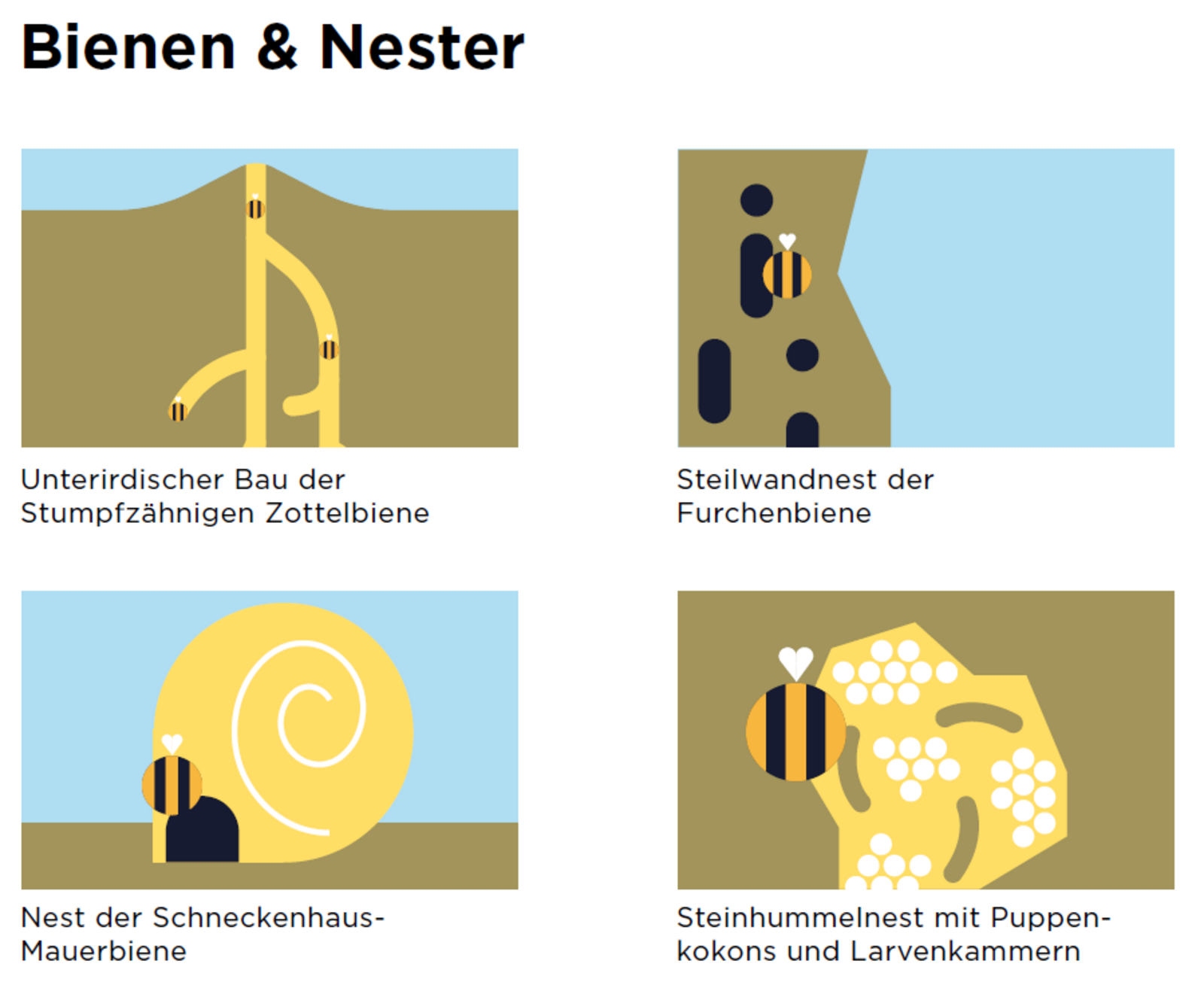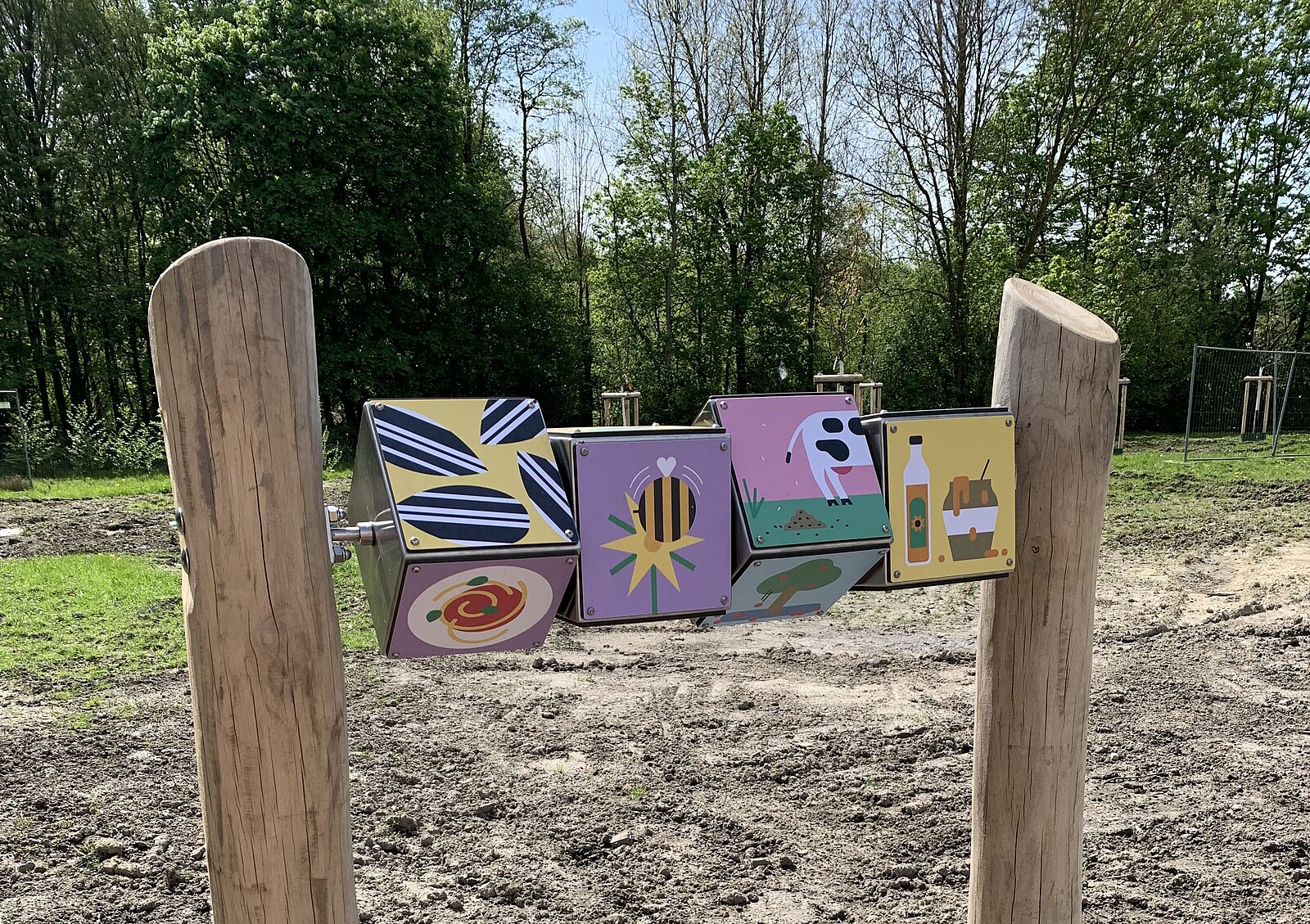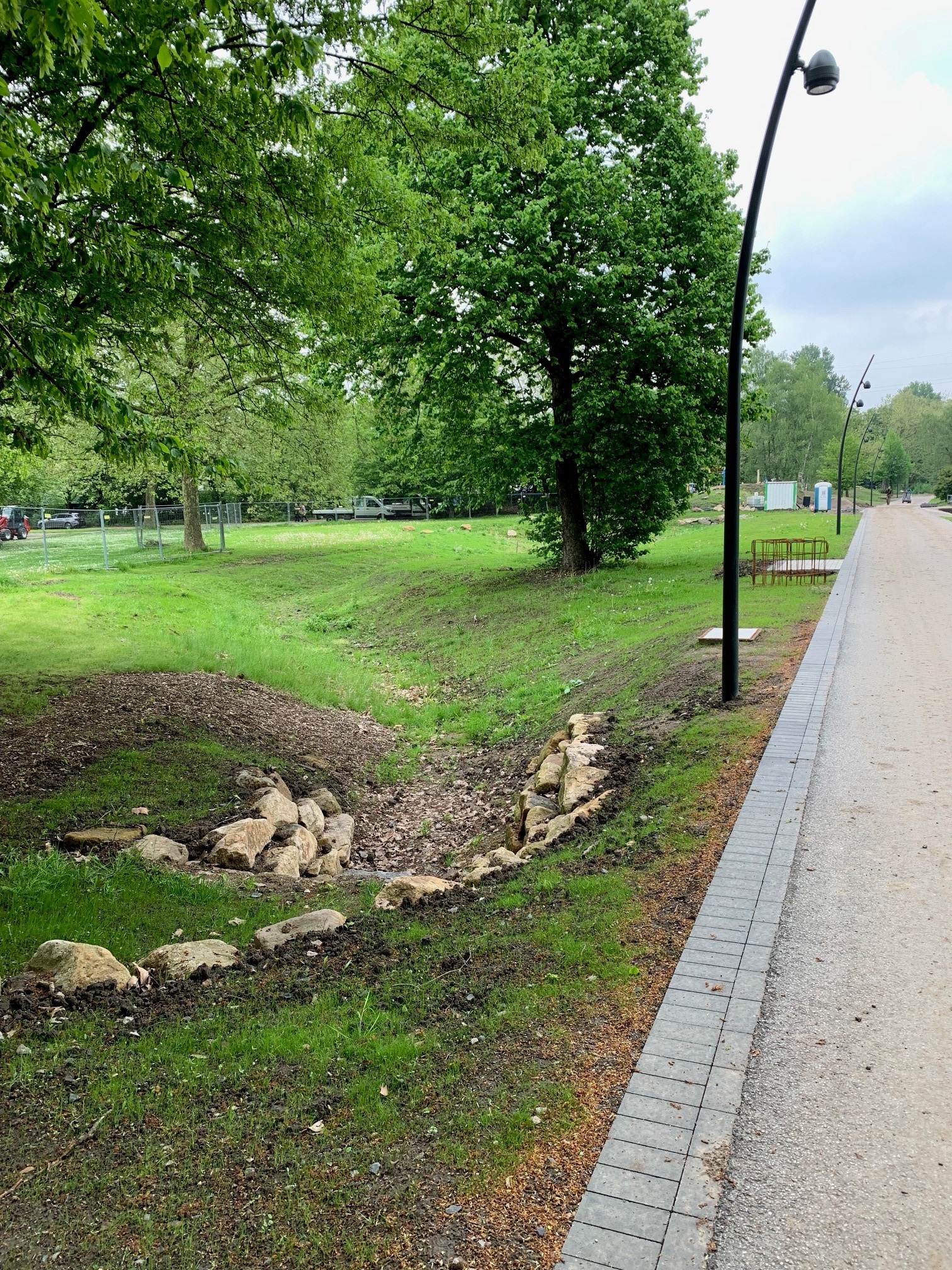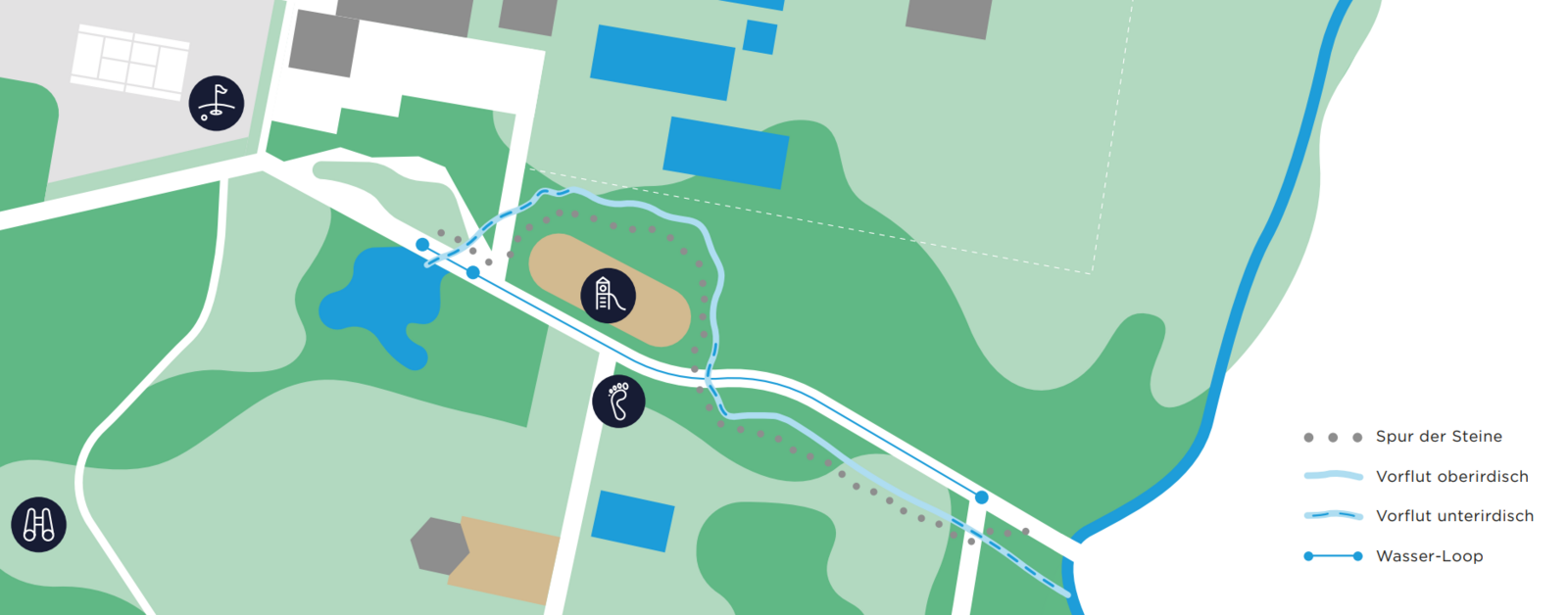Bee and Water Trail Nienhausen
Bee trail
Wild bees and honey bees
Who likes to lay an egg at Easter? - Some bees do!
Some wild bees lay their eggs in their nests as early as February. They also store a pollen cake, made of flower pollen and nectar. Once the hatched larva has eaten the pollen cake, it spins a cocoon. In spring, it emerges from its cocoon as a wild bee. Most wild bees are solitary.
Bumblebees belong to the genus of wild bees, except that they live in small colonies. In spring, the queens lay eggs in contiguous brood cells, made of wax. The larvae are nourished with honey, which the females produce in limited quantities. Honey bees survive only as a colony. In the hives, the queens lay their eggs in hexagonal combs. The honey bees then feed the larvae with royal jelly.
All female bees have a stinger and a venom bladder. Honey bees defend their honey stores and their colony. They sting only when they feel threatened, but try to avoid stinging whenever possible, as they die afterward. Most wild bees are harmless to humans because they do not have a colony or honey to defend. They also have a very sensitive sting. The bumblebees protect their colony by stinging in case of emergency. They give a warning in advance by raising their middle leg towards the threat, lying on their back, and emitting a distinct buzzing sound. Wild bees, in particular, play a crucial role in the pollination of our food crops, including strawberries, pears, cherries, pumpkins, and more.
Further information
The remarkable transformation of all bees: they transform from an egg to a bee. During this process, they appear very different from the bees we see outside. This phenomenon is scientifically known as metamorphosis. There are other animals that also experience a significant metamorphosis. For instance, anurans, such as frogs and toads, initially live as tadpoles in the water and later transition to life on land. The caterpillar, which eventually transforms into a butterfly, bears resemblance to the larva of a bee. However, wild bees and honey bees only emerge from their nests once their wings have fully developed.
The availability of honey today is largely attributed to modern beekeeping. In this method, bee colonies are housed in rectangular boxes, known as beehives, which accommodate a significant population of individual bees. Honey bees, in particular, rely heavily on human assistance to maintain their well-being and overall health.
Wild honey bees, which make their nests in spacious tree cavities, formed - for instance - by woodpeckers, are a rarity nowadays. Compared to managed honey bee colonies, wild honey bees face a lower risk of disease transmission due to the larger distances between their tree dwellings and the smaller number of bees within their colonies.
Bees & nests
Wild bees typically nest in various habitats, including soil, sand, clay soils, as well as wall or mouse holes, rotten or fresh wood, and plant stems. Do you spot the entrances of their nests? Consider observing the upright nesting structures, crafted from durable Robinia wood. Alternatively, you can explore the ground and sunny slopes, but be careful to avoid harming the nests.
Further information
Key factors to consider when constructing nesting habitats for wild bees
Nesting aid for sand bees: A sand patch is almost like a sand bed for baby bees. Make it sunny, dry, up to 20-50 cm deep and slightly hilly. To promote good water penetration into the soil, it is advisable to use slightly loamy sand. This type of soil allows water to permeate effectively from below.
Mound for baby bees: Mix garden soil with sand and form a mound. Using a looser material facilitates the creation of nesting tunnels and allows rainwater to drain more quickly. Plant growth should be sparsely cultivated so that the soil remains loose.
Wooden nesting aids: Use a matured, hard wood, as dry and splinter-free as possible, so that the bees can fly in without injury and remain healthy.
Drill holes: As long as possible (greater than 5 cm) to provide protection against woodpeckers; with various hole diameters ranging from 2 to 12 mm to accommodate different wild bee species. Smooth the edges. Provide a roof on the northwest side for weather protection. Orientation: South-east facing, in a sunny location with a clear flight path. Ideally, protect against birds with wire mesh and long drill holes.
If you would like to see another traditional nesting aid, visit the bee hotel on the meadow, called “Ziegenmichel's Wiese”.
Bees & water
Give water to the bees!
Water is important for wild bees as it enables plants to produce sweet nectar in their flowers. Bees need the nectar as fuel and to prepare pollen cakes. Wild bees also use water to mix with clay, small stones, resin, or plant parts, creating a type of mortar that they use to line their nests and seal the entrances. This protective layer helps safeguard their nests from the weather. Honey bees use water to clean their bodies and to cool their hives: air conditioning through wing flapping!
Due to the scarcity of water sources, bees use the properties of certain plants to provide themselves with the water they need. For instance, in the morning, dewdrops collect on the leaves of lady's mantle, and the leaf axils of cardoon, a thistle-like plant, act as small water reservoirs.
Bees also need water to build and cool their nests. Use the water from your water bottle or another vessel to help them.
If you´re in the park: Fill the clay circles on the right side at the trail with water.
Bees avoid open water surfaces, so make the water stations bee-friendly by creating small islands, using natural materials such as stones with moss, branches, or leaves. These serve as swimming aids for the bees and should also be arranged at the edge because the bees prefer to sit at the shallow, warmer water's edge, where the water is enriched with minerals. Ideally, the water station should be exposed to the sun in the morning.
Bees & plants
They belong together!
They need each other to survive and reproduce. Throughout their ongoing evolutionary history, they have been adapting to each other for millions of years. Certain wild bees have developed particularly long proboscises to sip nectar from specific plants, while certain plants have developed scents to attract special species of wild bees.
Which bees fly to which plant families? Find the suitable plant beds for different bee families!
The so-called Pantaloon bees fly to the chicory, a plant belonging to the composite family.
Small Scissor bees like plants from the bellflower plant family best.
The Banded Mud bee thrives best on the flat pea for feeding. This plant belongs to the fabaceae family.
The Fork-tailed Flower bees prefer labiates, such as the hedge woundwort.
The Common Carder bees, on the other hand, take flower sap and pollen from all five plant families listed here.
Give and take
What role does the bee play? Spin the wheel of the life cycle game! Find the correct order from seed to food.
Life is sustained through the exchange of nutrients: humans, animals and plants give and take from each other. Look at the following examples:
When an apple tree grows from a seed, the fruit remains a surprise. To ensure the growth of a specific apple variety on a tree, an artificial grafting process is employed: a branch of the desired variety is carefully joined to a compatible tree. After the grafting process, the tree is meticulously pruned to promote a plentiful harvest. Bees play a crucial role in pollinating the blossoms of the tree, gathering the sweet nectar to fuel their flight and collecting the nutritious pollen to nourish their offspring. Eventually, the fruits ripen and can be transformed into delightful apple juice, among other delicious products.
People sow tomato seeds in pots to protect the young seedlings from nibbling animals. The growing plant is supported by spiral stakes. In nature, wind aids in the pollination of tomato flowers. However, bumblebees excel at this task by vigorously shaking the blossoms.
The cow drops its dung on the ground, which contains nutrients and seeds of the grasses and herbs it ate. From these seeds in the cow dung, grasses and herbs sprout and bloom once again. Grasses are pollinated by the wind, while herbs are pollinated by bees. They provide essential nutrition for the cows and find their way into the milk for the calves and humans. Therefore, it is important to take care of both the pastures and the cows that graze upon them.
How do you describe the life cycle of the sunflower seed?
Further information
The sunflower is a summer flower that blooms later in the season. It thrives in warm and sunny conditions until fall, attracting honey bees (the fair weather flyers) to collect its pollen. Bumblebees, on the other hand, rely on flowering plants from spring to fall, as they would starve within just three days without the nourishing pollen and energy-rich nectar.
The head of a sunflower consists of over 800 very small individual flowers. Bees are attracted to this sweet food and collect it to bring it back to their nests. For this purpose, some bees have fine hairs on their legs, while others have them on their abdomens, which help them gather the nectar and pollen. As they visit other flowers, some of the pollen sticks to the flower, resulting in pollination. Honey bees use the collected pollen to produce honey, while wild bees use it to create a food supply for their larvae, also known as brood.
Pollinated flowers turn into fruits. Once the many fruits of the sunflower, the seeds, have ripened, many birds feed on the nutritious food. These seeds contain very healthy oils, which are used to produce high-quality cooking oil.
In the early part of the year, when temperatures are still cool and moisture is abundant, early blooming fruit trees rely heavily on early-flying wild bees for pollination - and vice versa. Early starters such as Mason bees and bumblebees are active even in bad weather. In the orchard, one can observe the constant interplay of giving and taking in nature throughout the year. In the Revierpark Nienhausen, cherry trees, pear trees, plum trees, as well as early and late blooming apple trees have been planted.
Research results indicate that fruits ripening in plantations, visited by various species of wild bees, are not only more flavourful but also healthier. Additionally, these plantations tend to yield a higher quantity of fruits.
Barefoot path
Allow your feet to breathe, move, relax, and feel the ground.
Connect with nature by walking on herbs, plant materials, bark mulch, stones, or sand, whether in the shade of trees or in the warm sunlight.
Walking on different surfaces stimulates the senses and the entire body, similar to foot reflexology. It improves blood circulation, strengthens muscles, tendons, and ligaments, and enhances joint mobility. Walking barefoot also helps prevent sweaty feet and athlete's foot. The tannins in the ground have an anti-fungal effect.
The barefoot path also leads to the health-promoting Kneipp facility, the herbal raised bed, and the sports fields. Embrace the experience and enjoy the benefits of connecting with nature through barefoot walking.
Rich in species
From wet meadow to grove
Observe plants and animals in different habitats. How much light and water can you find in the different areas? What is the soil like there?
Find a comfortable place at the wooden borders and explore the variety of plants and animals in these areas. Take a moment to count how many different plants you can discover within the wooden borders. And how about the number of animals? Now, imagine similarly sized areas a bit closer to the forest's edge and compare your observations.
Here, you can observe diverse plant communities: the herbs and grasses in the meadow, as well as the shrubs and trees. This development, starting from the low meadow and progressing towards the forest, is known as succession. The term is derived from Latin and means "to follow." The plant communities, along with the presence of animals, create successive, diverse, and beneficial ecosystems.
1) Meadow and individual shrubs and trees at the edges.
2) New shrubs and trees have settled in the species-rich meadow. These stages of development are preserved through maintenance in the Revierpark.
3) Natural forest development without maintenance measures outside of park areas.
Further information
Our habitat thrives when it boasts a rich variety of plant species, including flowers, grasses, herbs, shrubs, and trees, as well as a diverse array of animal species such as bees, beetles, butterflies, spiders, and grasshoppers. Even the smallest areas with a multitude of plant and animal species contribute to the resilience and adaptability of our environment. On the wet meadow, you will notice wooden trunks arranged in the shape of "windows," each side measuring one meter in length, creating one square meter per window. Every square meter counts! That means: Every square meter is very important! These areas provide an ideal opportunity for observing and counting the diverse creatures inhabiting them.
Bio means life - diversity means variety. Increasing biodiversity helps all living beings on this earth!
Water trail
It trickles, dribbles, rains, splashes, sloshes and bubbles, seeps away, evaporates, overflows and cools. Here you experience what water can all do. The course of the water playground leads you – similar to nature – from the source to the mouth: water comes from a spring, runs gently at first, then flows faster and collects. It turns from a brook into a river and finally flows into the sea. Here you can refresh yourself, watch and splash around.
The green hollows on the other side of the path absorb the water from the water playground. This creates habitats and water reserves for flora and fauna. They also function as a natural air conditioner and cool the environment. And in the event of heavy rainfall they protect against flooding. Follow the little boulders. At the end of the stone trail you will be told how the hollows protect us from flooding.
Wolkenplatz – Cloud Square
The “Wolkenplatz” (translated: cloud square) is dedicated to the water cycle of trees, soil and air.
Let it rain from the clouds! Below you, you will notice surfaces with different textures, ranging from fine to coarse, allowing rainwater to infiltrate to varying degrees. Take a moment to observe: Where does the water disappear more rapidly, and where does it struggle to permeate, resulting in longer retention?
After the water has infiltrated the soil, it travels through a network of pipes formed by the roots, trunk, and branches, reaching every individual leaf of the trees. Along with the water, nutrients from the soil are also transported. Through tiny openings on the underside of the leaves, the water evaporates, resulting in a cooling effect on the surrounding environment. This way, the tree functions as a natural air conditioner. In addition, the evaporated water contributes to the formation of clouds. The moisture-laden, warm air rises into the sky and cools down, leading to the condensation of water vapour on tiny dust particles. These condensed droplets join together to form larger clouds. Eventually, when the cloud reaches its capacity and can no longer hold the moisture, it releases it in the form of rain. This marks the beginning of a new cycle, as the rainwater replenishes the Earth, allowing the process to repeat itself.
1) Evaporation through the leaves.
2) Water transport from the roots to the leaves.
3) Water absorption through the roots.
Sensation
Press the button - let it rain...
Spread your arms and imagine you were a tree, standing in the forest.
From the roots to the top, a large oak tree can transpire water in an amount equivalent to 4 bathtubs in a day! Transpiration is similar to sweating, and it creates a cooling effect on our skin.
Research
Go ahead and do a research! Place a small bag over the leaves of plants and seal it tightly with a string or a clothespin. You can observe how much water the plant releases. This experiment requires some patience, but after approximately 2 hours (in an environment with a temperature of around 10 degrees Celsius or warmer), you will notice changes through your senses. You can explore the bag visually or open it and feel the moisture with your finger.
The sunken, green area next to the so called “Wolkenplatz”, sometimes wet and sometimes dry, is known as a swale. This periodically moist habitat is home to plants such as meadowsweet, water mint, purple loosestrife, and water wort, which not only add to the beauty with their blossoms but also attract unique wildlife.
Pre-flood
... means "before the flood": During heavy rains, water is also collected in the swales and stored to some extent for periods of heat and drought. Between the water playground, the “Wolkenplatz” and "Schwarzbach" stream, small boulders mark the outflow of water to the “Schwarzbach” stream.
Pre-flood measures in Revierpark Nienhausen ensure that excess water, which the park cannot absorb during heavy rain, is redirected before meadows, paths, squares, and planting areas become flooded.
This "superfluous" water flows into the Schwarzbach stream. Follow the trail of small boulders back to the source stone at the water playground. They indicate the aboveground swales and the underground drainage points for the pre-flood system. The stone trail follows a portion of the rainwater route, which was established in 2001 by the Emschergenossenschaft as a demonstration of nature-based rainwater management. The water intentionally drains slowly through the aboveground channels and swales. This creates space for new life and more biodiversity. These moist areas are home to distinct plants and animals, compared to dry regions. Moreover, they function as natural air conditioners, cooling down the surrounding environment through evaporation and providing fresh air to the adjacent residential areas.














